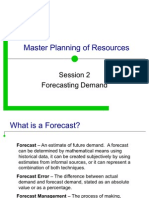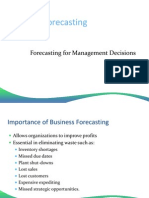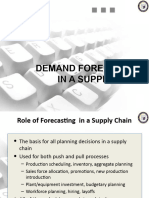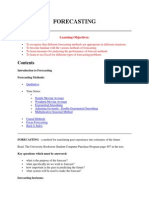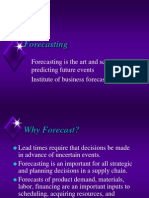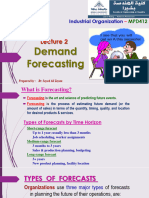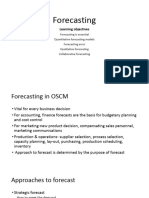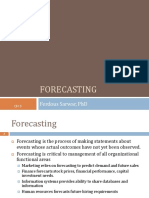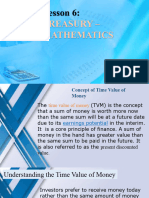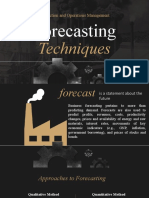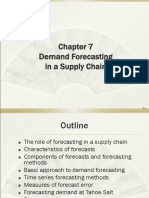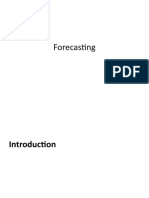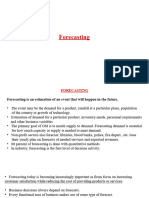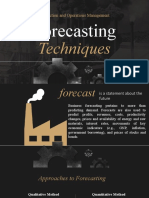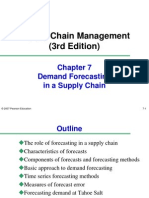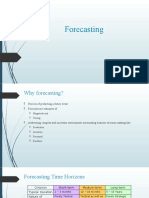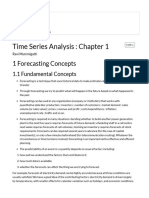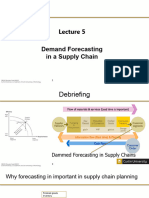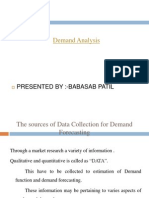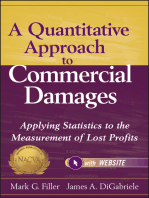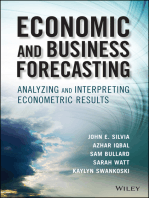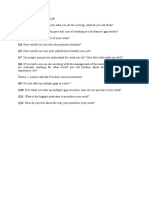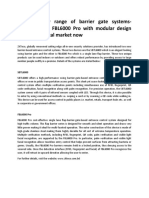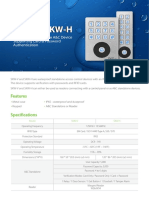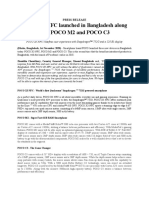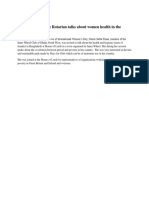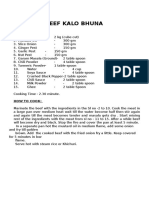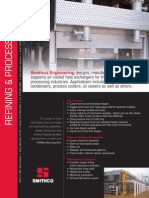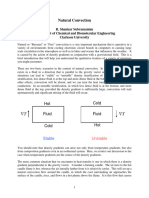0 ratings0% found this document useful (0 votes)
31 viewsLecture - 07: Demand Forecasting in A Supply Chain
Lecture - 07: Demand Forecasting in A Supply Chain
Uploaded by
Shahriar RahmanThis document discusses demand forecasting in supply chains. It explains that demand forecasts are used for strategic planning and push/pull processes. Forecasts become less accurate over longer time horizons and at higher aggregation levels. Qualitative, time series, and causal methods are used to forecast systematic demand components like level, trend, and seasonality. The goal is to predict systematic demand and estimate random error. Adaptive forecasting iteratively updates estimates based on forecast errors.
Copyright:
© All Rights Reserved
Available Formats
Download as PPSX, PDF, TXT or read online from Scribd
Lecture - 07: Demand Forecasting in A Supply Chain
Lecture - 07: Demand Forecasting in A Supply Chain
Uploaded by
Shahriar Rahman0 ratings0% found this document useful (0 votes)
31 views14 pagesThis document discusses demand forecasting in supply chains. It explains that demand forecasts are used for strategic planning and push/pull processes. Forecasts become less accurate over longer time horizons and at higher aggregation levels. Qualitative, time series, and causal methods are used to forecast systematic demand components like level, trend, and seasonality. The goal is to predict systematic demand and estimate random error. Adaptive forecasting iteratively updates estimates based on forecast errors.
Original Description:
SupplyChain Management
IBA Dhaka University
Original Title
Lecture 7
Copyright
© © All Rights Reserved
Available Formats
PPSX, PDF, TXT or read online from Scribd
Share this document
Did you find this document useful?
Is this content inappropriate?
This document discusses demand forecasting in supply chains. It explains that demand forecasts are used for strategic planning and push/pull processes. Forecasts become less accurate over longer time horizons and at higher aggregation levels. Qualitative, time series, and causal methods are used to forecast systematic demand components like level, trend, and seasonality. The goal is to predict systematic demand and estimate random error. Adaptive forecasting iteratively updates estimates based on forecast errors.
Copyright:
© All Rights Reserved
Available Formats
Download as PPSX, PDF, TXT or read online from Scribd
Download as ppsx, pdf, or txt
0 ratings0% found this document useful (0 votes)
31 views14 pagesLecture - 07: Demand Forecasting in A Supply Chain
Lecture - 07: Demand Forecasting in A Supply Chain
Uploaded by
Shahriar RahmanThis document discusses demand forecasting in supply chains. It explains that demand forecasts are used for strategic planning and push/pull processes. Forecasts become less accurate over longer time horizons and at higher aggregation levels. Qualitative, time series, and causal methods are used to forecast systematic demand components like level, trend, and seasonality. The goal is to predict systematic demand and estimate random error. Adaptive forecasting iteratively updates estimates based on forecast errors.
Copyright:
© All Rights Reserved
Available Formats
Download as PPSX, PDF, TXT or read online from Scribd
Download as ppsx, pdf, or txt
You are on page 1of 14
Lecture – 07
Demand Forecasting in a Supply Chain
The basis for all strategic and planning decisions in a
supply chain
Used for both push and pull processes
Examples:
Production: scheduling, inventory, aggregate planning
Marketing: sales force allocation, promotions, new
production introduction
Finance: plant/equipment investment, budgetary
planning
Personnel: workforce planning, hiring, layoffs
All of these decisions are interrelated
Forecasts are always inaccurate, so should include expected
value and measure of error.
Long-term forecasts are less accurate than short-term
forecasts (forecast horizon is important)
Aggregate forecasts are more accurate than disaggregate
forecasts
The farther up the supply chain a company is (or the farther
it is from the consumer), the greater the distortion of
information it receives
Numerous factors influence the demand forecast,
including the following:
Past demand
Lead time of product replenishment
Planned advertising or marketing efforts
Planned price discounts
State of the economy
Actions that competitors have taken
A company must understand such factors before it can
select an appropriate forecasting methodology.
Qualitative: primarily subjective; rely on judgment and
opinion
Time Series: use historical demand only
Static
Adaptive
Causal: use the relationship between demand and
some other factor to develop forecast
Simulation
Imitate consumer choices that give rise to demand
Can combine time series and causal methods
Observed demand (O) =
Systematic component (S) + Random component (R)
Level (current deseasonalized demand)
Trend (growth or decline in demand)
Seasonality (predictable seasonal fluctuation)
• Systematic component: Expected value of demand
• Random component: The part of the forecast that deviates
from the systematic component
• Forecast error: difference between forecast and actual demand
The following five points are important for an
organization to forecast effectively:
Understand the objective of forecasting.
Integrate demand planning and forecasting throughout
the supply chain.
Identify the major factors that influence the demand
forecast.
Forecast at the appropriate level of aggregation.
Establish performance and error measures for the
forecast.
The goal of any forecasting method is to predict the
systematic component of demand and estimate the random
component.
The systematic component of demand data contains a level, a
trend, and a seasonal factor.
Systematic component = level * trend * seasonal factor
Systematic component = level + trend + seasonal factor
Systematic component = 1level + trend2 * seasonal factor
The specific form of the systematic component applicable to
a given forecast depends on the nature of demand.
Companies may develop both static and adaptive forecasting
methods for each form.
Assume a mixed model:
Systematic component = (level + trend)(seasonal factor)
Ft+l = [L + (t + l)T]St+l
= forecast in period t for demand in period t + l
L = estimate of level for period 0
T = estimate of trend
St = estimate of seasonal factor for period t
Dt = actual demand in period t
Ft = forecast of demand in period t
Before estimating level and trend, demand data must be
deseasonalized
Deseasonalized demand = demand that would have
been observed in the absence of seasonal fluctuations
Periodicity (p)
the number of periods after which the seasonal cycle
repeats itself
for demand at Tahoe Salt (Table 7.1, Figure 7.1) p = 4
Use the previous equation to calculate deseasonalized
demand for each period
St = Dt / Dt = seasonal factor for period t
The seasonal factors for the other periods are calculated in
the same manner
The overall seasonal factor for a “season” is then obtained by
averaging all of the factors for a “season”
If there are r seasonal cycles, for all periods of the form pt+i,
1<i<p, the seasonal factor for season i is
Si = [Sum(j=0 to r-1) Sjp+i]/r
The estimates of level, trend, and seasonality are adjusted after
each demand observation
General steps in adaptive forecasting:
Initialize
Forecast
Estimate error
Modify estimates
Examples:
Moving average
Simple exponential smoothing
Trend-corrected exponential smoothing (Holt’s model)
Trend- and seasonality-corrected exponential smoothing (Winter’s
model)
You might also like
- Mason - Forever Too Far Ch40-70 PDF 2Document22 pagesMason - Forever Too Far Ch40-70 PDF 2NerinaBurgosNo ratings yet
- APICS MRP Session02Document44 pagesAPICS MRP Session02Maxim AntonyukNo ratings yet
- Aggregate Planning: Green Mills Case Study: Assignment OnDocument1 pageAggregate Planning: Green Mills Case Study: Assignment OnShahriar RahmanNo ratings yet
- Demand Forecasting in A Supply ChainDocument25 pagesDemand Forecasting in A Supply ChainArnab DasNo ratings yet
- Demand Forecasting in Supply ChainDocument18 pagesDemand Forecasting in Supply ChainAnik Alam100% (3)
- Demand Forecasting - Prerequisites of A Good ForecastDocument15 pagesDemand Forecasting - Prerequisites of A Good ForecastPrachiranjan SwainNo ratings yet
- ICMarketing CourseDocument30 pagesICMarketing CourseSwapnikChimalamarriNo ratings yet
- Demand Forecasting: Prof. Ravikesh SrivastavaDocument29 pagesDemand Forecasting: Prof. Ravikesh SrivastavaShrey DattaNo ratings yet
- Demand ForecastingDocument26 pagesDemand ForecastingYose At The KahyanganNo ratings yet
- Forecasting Summary NotesDocument9 pagesForecasting Summary NotesJennybabe PetaNo ratings yet
- Demand Forecasting in A Supply Chain: Chopra and Meindl, Chapter 4Document43 pagesDemand Forecasting in A Supply Chain: Chopra and Meindl, Chapter 4Girish Dey0% (1)
- Chapter 2 ForecastingDocument42 pagesChapter 2 Forecastingworkumogess3100% (1)
- ForecastingDocument27 pagesForecastingArun Madhab BorahNo ratings yet
- Supply Chain Management: By: Rohit Deshmukh For: Semester - IDocument35 pagesSupply Chain Management: By: Rohit Deshmukh For: Semester - IPranit padhiNo ratings yet
- Demand ForecastingDocument26 pagesDemand ForecastingArepally SukumarNo ratings yet
- ForecastingDocument31 pagesForecastinghananshahid96No ratings yet
- Forecasting: Forecasting Is The Art and Science of Predicting Future Events Institute of Business ForecastingDocument24 pagesForecasting: Forecasting Is The Art and Science of Predicting Future Events Institute of Business ForecastingKalyan MurmuNo ratings yet
- SCM-4-Demand Forecasting - PPT Version 1Document51 pagesSCM-4-Demand Forecasting - PPT Version 1Monirul Islam100% (1)
- OM - ForecastingDocument35 pagesOM - ForecastingUN-HABITAT NepalNo ratings yet
- Forecasting 1Document27 pagesForecasting 1Abhishek KumarNo ratings yet
- Demand Forecasting - Lecture NotesDocument30 pagesDemand Forecasting - Lecture Noteshjahongir100% (1)
- MPD412 - Ind Org - Lecture-02-Forecasting - Part ADocument26 pagesMPD412 - Ind Org - Lecture-02-Forecasting - Part AMohamed OmarNo ratings yet
- Week 3 Forecasting - Lecture 3-4 (04 Oct, 2024)Document22 pagesWeek 3 Forecasting - Lecture 3-4 (04 Oct, 2024)ibaemba39No ratings yet
- ForecastingDocument30 pagesForecastingbittu00009No ratings yet
- ForecastingDocument34 pagesForecastingMitu Sanjida0% (1)
- Ch07 Forecasting ModellingDocument32 pagesCh07 Forecasting ModellingArnab TripathyNo ratings yet
- Treasury 6 Part 1Document29 pagesTreasury 6 Part 1sobiric395No ratings yet
- Chapter 9 - Forecasting TechniquesDocument50 pagesChapter 9 - Forecasting TechniquesPankaj MaryeNo ratings yet
- Forecasting TechniquesDocument26 pagesForecasting TechniquesColeen OrbegosoNo ratings yet
- Demand Forecasting in A Supply ChainDocument43 pagesDemand Forecasting in A Supply ChainKerilNo ratings yet
- Module 6: Introduction To Time Series Forecasting: Titus Awokuse and Tom IlventoDocument26 pagesModule 6: Introduction To Time Series Forecasting: Titus Awokuse and Tom IlventoAshutoshSrivastavaNo ratings yet
- Demand ForecastingDocument41 pagesDemand ForecastingPooja Surana100% (1)
- 8.demand Forecasting in A Supply ChainDocument24 pages8.demand Forecasting in A Supply ChainMuji_MSNo ratings yet
- Time Series Analysis and ForecastingDocument10 pagesTime Series Analysis and ForecastingshivguruashishNo ratings yet
- Demand Forecasting: Prof. A.N. SahDocument24 pagesDemand Forecasting: Prof. A.N. SahhadspotNo ratings yet
- Ch05 ForecastingDocument28 pagesCh05 ForecastingThien TranNo ratings yet
- Forecasting: Submitted By: Bindu Thushara. N Igtc Date: October 02, 2013Document28 pagesForecasting: Submitted By: Bindu Thushara. N Igtc Date: October 02, 2013NB Thushara Harithas100% (1)
- Forecasting FundamentalsDocument5 pagesForecasting FundamentalsSusiedeLeonNo ratings yet
- ForecastingDocument47 pagesForecastingAkshit GoelNo ratings yet
- CompanionAsset 9780128150757 Primer On Cash Flow ForecastingDocument7 pagesCompanionAsset 9780128150757 Primer On Cash Flow ForecastingPhạm Hồng Trang Alice -No ratings yet
- ForecastingDocument5 pagesForecastingDaphne Joyce NocilladoNo ratings yet
- Forecasting TechniquesDocument26 pagesForecasting TechniquesColeen OrbegosoNo ratings yet
- SCM Report On Demand ForecastingDocument43 pagesSCM Report On Demand ForecastingFaizan S. PuriNo ratings yet
- BSA Unit-II Topic - Time Series & Index No.Document55 pagesBSA Unit-II Topic - Time Series & Index No.singhsaurabhh91No ratings yet
- Session 10 - ForecastingDocument21 pagesSession 10 - Forecastingchandel08No ratings yet
- Forecasting Lec 1 & 2 EditedDocument27 pagesForecasting Lec 1 & 2 EditedJungle DiffNo ratings yet
- Chapter 3 - ForecastingDocument28 pagesChapter 3 - ForecastingDahlia Abiera OritNo ratings yet
- Time Series Forecasting FundamentalsDocument37 pagesTime Series Forecasting Fundamentalsravi mNo ratings yet
- Sales MGMT Chapter 3Document20 pagesSales MGMT Chapter 3Ambese SmartNo ratings yet
- Session 5b - PMFDocument3 pagesSession 5b - PMFgodondiegiNo ratings yet
- MGMT2017 Lecture 05Document49 pagesMGMT2017 Lecture 05RoamerNo ratings yet
- Demand Estimation and ForecastingDocument4 pagesDemand Estimation and Forecasting'mYk FavilaNo ratings yet
- ForcastingDocument21 pagesForcastingBhabesh kumar senapatiNo ratings yet
- ForecastingDocument11 pagesForecastingJeremias Pangisban Jr.No ratings yet
- Unit 2 BsaDocument53 pagesUnit 2 Bsasinghsaurabhh91No ratings yet
- ForecastingDocument58 pagesForecastingAnonymous ZHGywrSNo ratings yet
- Demand Forecasting - Principles and MethodsDocument62 pagesDemand Forecasting - Principles and MethodsNagaraju Gummadi67% (3)
- Demand ForecastingDocument28 pagesDemand ForecastingRamteja SpuranNo ratings yet
- Demand Analysis PPT MbaDocument24 pagesDemand Analysis PPT MbaBabasab Patil (Karrisatte)0% (1)
- Financial Plans for Successful Wealth Management In Retirement: An Easy Guide to Selecting Portfolio Withdrawal StrategiesFrom EverandFinancial Plans for Successful Wealth Management In Retirement: An Easy Guide to Selecting Portfolio Withdrawal StrategiesNo ratings yet
- A Quantitative Approach to Commercial Damages: Applying Statistics to the Measurement of Lost ProfitsFrom EverandA Quantitative Approach to Commercial Damages: Applying Statistics to the Measurement of Lost ProfitsNo ratings yet
- Economic and Business Forecasting: Analyzing and Interpreting Econometric ResultsFrom EverandEconomic and Business Forecasting: Analyzing and Interpreting Econometric ResultsNo ratings yet
- References:: Research. Thousand Oaks, CA: Sage PublicationsDocument2 pagesReferences:: Research. Thousand Oaks, CA: Sage PublicationsShahriar RahmanNo ratings yet
- Theme 1Document1 pageTheme 1Shahriar RahmanNo ratings yet
- Zkteco'S New Range of Barrier Gate Systems-Sbtl6000 and Fbl6000 Pro With Modular Design Available in Local Market NowDocument1 pageZkteco'S New Range of Barrier Gate Systems-Sbtl6000 and Fbl6000 Pro With Modular Design Available in Local Market NowShahriar RahmanNo ratings yet
- SKW-V+&+SKW-H Leaflet 20201009Document2 pagesSKW-V+&+SKW-H Leaflet 20201009Shahriar RahmanNo ratings yet
- ZKTeco MB560-VL PRDocument1 pageZKTeco MB560-VL PRShahriar Rahman100% (1)
- League of Legends DetailsDocument62 pagesLeague of Legends DetailsShahriar RahmanNo ratings yet
- POCO Release ENDocument2 pagesPOCO Release ENShahriar RahmanNo ratings yet
- Family Plan CGS SchoolDocument1 pageFamily Plan CGS SchoolShahriar RahmanNo ratings yet
- China Accelerates Plans To Put A Leash On Its Internet GiantsDocument2 pagesChina Accelerates Plans To Put A Leash On Its Internet GiantsShahriar RahmanNo ratings yet
- Case Study: Seven Eleven Japan Co.: Assignment: 3Document4 pagesCase Study: Seven Eleven Japan Co.: Assignment: 3Shahriar RahmanNo ratings yet
- USAID SOLICITATION - Project Mgt. Specialist Economist FSN-12 0Document7 pagesUSAID SOLICITATION - Project Mgt. Specialist Economist FSN-12 0Shahriar RahmanNo ratings yet
- UNICERT Celebrates Achievement of The First Accredited ISO Certification Body & CMMI Partner in BDDocument1 pageUNICERT Celebrates Achievement of The First Accredited ISO Certification Body & CMMI Partner in BDShahriar Rahman100% (1)
- Media Invitation From GPDocument1 pageMedia Invitation From GPShahriar RahmanNo ratings yet
- Press Release Rotarian BangladeshiDocument1 pagePress Release Rotarian BangladeshiShahriar RahmanNo ratings yet
- Chapter 1 SummaryDocument1 pageChapter 1 SummaryShahriar RahmanNo ratings yet
- D'Q-Avcbvi KVR MNR Kivi GK Abb Vu© MN HVMX: WWW - Udoy.CoDocument1 pageD'Q-Avcbvi KVR MNR Kivi GK Abb Vu© MN HVMX: WWW - Udoy.CoShahriar RahmanNo ratings yet
- Premium Beef Kalo Bhuna & Premium Achari Khichuri RecipeDocument2 pagesPremium Beef Kalo Bhuna & Premium Achari Khichuri RecipeShahriar Rahman100% (1)
- Taking Bangladesh To The Next LevelDocument23 pagesTaking Bangladesh To The Next LevelShahriar RahmanNo ratings yet
- Public Opinion Survey On Corruption in Public Service Delivery Agencies in DhakaDocument4 pagesPublic Opinion Survey On Corruption in Public Service Delivery Agencies in DhakaShahriar RahmanNo ratings yet
- JLG 1930ES Parts ManualDocument380 pagesJLG 1930ES Parts ManualpatricioNo ratings yet
- Experiment 7 Molecular Geometry 7.1 Objectives: SKU3073 Chemistry Semester 1 2020/2021Document6 pagesExperiment 7 Molecular Geometry 7.1 Objectives: SKU3073 Chemistry Semester 1 2020/2021Maldini JosnonNo ratings yet
- Highways Engineering IDocument241 pagesHighways Engineering IAnonymous 2z9S8CqNo ratings yet
- Eng 25a English Listening Speaking and GrammarDocument3 pagesEng 25a English Listening Speaking and GrammarEzio Auditore80% (5)
- Impact of Committment of Employees in Bpo SectorDocument16 pagesImpact of Committment of Employees in Bpo SectorPayal SikkaNo ratings yet
- Bluetooth Module Datasheet: Model: TS64215Document11 pagesBluetooth Module Datasheet: Model: TS64215StefanoViganóNo ratings yet
- Workplan MSP Bobonaro & Ermera Municipalities Timor Leste - 12.06.2021Document1 pageWorkplan MSP Bobonaro & Ermera Municipalities Timor Leste - 12.06.2021Wendy prayudaNo ratings yet
- The Aging Process Introduction (Final Revision)Document25 pagesThe Aging Process Introduction (Final Revision)Karla ÁngelaNo ratings yet
- The Kinetics of A Bleach ReactionDocument4 pagesThe Kinetics of A Bleach ReactionJelena ZdravkovicNo ratings yet
- Mtl7700 Range Barrier Applications: Analogue Inputs (High Level)Document6 pagesMtl7700 Range Barrier Applications: Analogue Inputs (High Level)AjayNo ratings yet
- 3 Steps Brochure FA WebDocument32 pages3 Steps Brochure FA Webtnha75No ratings yet
- LP ExamplesDocument2 pagesLP ExamplesRajeevManojMNo ratings yet
- Brief Introduction of CNPC JPECDocument42 pagesBrief Introduction of CNPC JPECMaria Fernanda Bonilla SalasNo ratings yet
- Wireless Senswor NetworkingDocument22 pagesWireless Senswor Networkingmilandixit01No ratings yet
- Smithco Product Brochure 2011Document8 pagesSmithco Product Brochure 2011Carlos Luis Esquerdo MarcanoNo ratings yet
- Natural Convection - 2Document7 pagesNatural Convection - 2Ali HegaigNo ratings yet
- JMO NumberTheoryDocument3 pagesJMO NumberTheorymike liuNo ratings yet
- Mills - Michel FoucaultDocument9 pagesMills - Michel FoucaultKalyar Ei Ei LwinNo ratings yet
- Revision For Writing 2 .2023Document10 pagesRevision For Writing 2 .2023hamham200212No ratings yet
- KTH Master Thesis OpponentDocument8 pagesKTH Master Thesis Opponentkatesubramanianwashington100% (1)
- Nippon Company Profile-Unlocked PDFDocument30 pagesNippon Company Profile-Unlocked PDFAthul T.NNo ratings yet
- Action Speak Louder Than Words EssayDocument8 pagesAction Speak Louder Than Words Essaydunqfacaf100% (2)
- OOPs Unit-4 and Unit-5 NotesDocument53 pagesOOPs Unit-4 and Unit-5 Notescst1No ratings yet
- Awakening To The InfiniteDocument13 pagesAwakening To The InfiniteOana BaraianNo ratings yet
- Four Visions of The Apocalypse Disintegration in The Early Work of J.G. BallardDocument103 pagesFour Visions of The Apocalypse Disintegration in The Early Work of J.G. BallardcalenhNo ratings yet
- IntrebariDocument8 pagesIntrebariSimona SanduNo ratings yet
- Phy 21 - SelectedDocument21 pagesPhy 21 - Selectedworkpriority79No ratings yet
- Activity Guide and Evaluation Rubric - Phase 3 - Participant - Observation PracticeDocument12 pagesActivity Guide and Evaluation Rubric - Phase 3 - Participant - Observation PracticeCaro Palta MedinaNo ratings yet
- Adaptasi Psikologis Ibu Hamil Dalam Pencapaian Peran Sebagai Ibu Di Puskesmas Kembaran Ii Kabupaten BanyumasDocument9 pagesAdaptasi Psikologis Ibu Hamil Dalam Pencapaian Peran Sebagai Ibu Di Puskesmas Kembaran Ii Kabupaten BanyumasNursyifa SofiantiNo ratings yet

